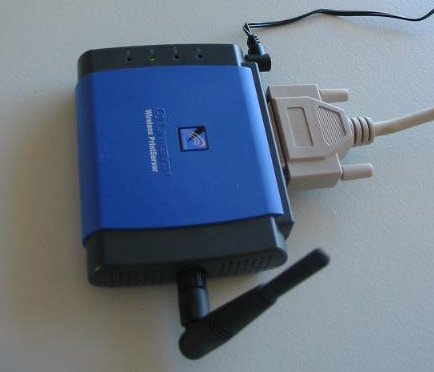
networking curriculum
support CD for senior
secondary studies
Topics
. Home
. Networking History
. Why network?
. OSI model
. Connecting up
. Protocols
. Technology
. Network types
. Topologies
. Issues
. Design factors
. Economic effects
. www links
. Site map
 networking >
connect up > wireless
networking >
connect up > wireless
Wireless
Radio connections have also undergone a similar evolution, becoming smaller and more diverse in their applications. Long distance radio communications are still the province of the microwave band covering terrestrial or space communications. These installations are probably more frequent than people realise with antennae on roof tops and usually reasonably protected areas.

A local antennae as shown are often communicating with complex central towers like the one pictured. These towers usually provide bases for multiple services eg telephony and tele-data. These connections provide bit rates in the mega-bit range quite easily. However their drawback is they only work on line of sight and as a result transmitter and receiver must be clear of obstructions. Planners of these networks need to pay attention to where and how high trees are going to grow, for example. Another drawback is if systems nearby use omnidirectional aerials that spray signals over a wide, indiscriminate area causing loss of signal integrity with other systems.

Consumers have many more "across the counter" options with wireless connections. These devices use the licence free wireless bands that provide access to the network. These devices are also finding their way into a broad range of domestic products through to commercial installations. The systems are made up of access points and user interfaces. The latest versions operate on the "free to air" 2.4GHz radio spectrum.

>wireless access point
The combination of different technologies now available is quite extraordinary.
The following technologies are combined with wireless links
- PCI card: for standard desktop computers
- Compact flash: for Personal Data Assistants
- PCMCIA Card: for Laptops
- USB Adapter: Laptops and desktops
- Router/Hub: Network Access points for ADSL distribution
The last example is but one combination of the many that are now available. For example some wireless devices provide an ADSL modem function to external broadband networks and provide a router and Network Address Translation (NAT) firewall functions and Internet gateway for the users’ network. Similar priced devices also provide switched Ethernet ports with CAT5/RJ45 connections, remote administration, Virtual Private Networks (VPN) and networked parallel ports to drive parallel printers. Other Wireless Access Points provide data security options with 128 bit WEP (Wired Equivalent Privacy) encryption and MAC address authentication. This diversification of function and interfaces associated with these wireless related devices is destined to become more sophisticated.

> wireless print server
The security of wireless technology as a connection system has raised many issues. The pre-wireless systems that limited access to known physical distribution points in a building, the normal CAT5/RJ45 Hub/Switch systems, provided very high security in many cases because of the high security of the buildings themselves. Wireless can easily break these barriers down as the signal leaks out of the physical boundaries. The other main problem, as hinted above, is that these devices are becoming cheaper very quickly and it is easy to add an unauthorised wireless point on a network. It is unlikely that such an access point will be set up with proper security. These points can expose networks that have long relied on physical isolation to complete the security of the network. to be accessed by unauthorised people over long enough periods of time for the simpler security approaches to be cracked. This is a fairly extreme example but even wireless systems that are planned to provide wide access to users, such as in schools or airport foyers, can greatly increase the threat of breakdowns in security. Unauthorised computers can be used in these situations for long periods of undetected access with powerful software to crack security systems.

There are also many wireless standards with different purposes. For example the Bluetooth standard is for distances of about 3-4 metres and is considered ideal for connecting devices within a small "personal" radius. The IEEE 802.11g standard provides a replacement for LAN hubs and switches. The microwave format is for long distance external connections. Obviously as the technology evolves these definitions and standards are always changing. The currently popular standard IEEE 802.11g (and currently IEEE 802.11i rapidly being put in place) has been developed through a number of previous standards that have been shown to have security weaknesses. As recent and highly "successful" virus attacks on the very core of some very popular operating system’s network interfaces show, maintaining security is an ongoing business. Two main aspects of security are first denying unwanted connections and the second is the encryption of the data held on the system. Currently the use of MAC addresses to validate interfaces is popular, but it is by no means a perfect method for authenticating connecting hardware, whilst 128bit WEP encryption is a powerful system of hiding the characteristics of the network, and the data it carries, from prying eyes. One of the major problems with security features on any computer product are the software must be installed and configured properly to provide maximum protection. The early problems with wireless security were often installations where even the most basic security features on offer were not "switched on".

worksheets
. history
. why network
. osi model
. connecting
. protocols
. technology
. topologies (tla)
. issues
. network types
. design
. economics
. economics (cs)
- solutions -
quizzes
. why network
. osi model
. connecting
. protocols
. technology
. topology
. issues
. network types
. design
. economics
| Home |
History |
Why Network? |
OSI Model |
Connecting up |
Protocols |
Technology |
Networks Types |
Topologies |
Issues |
Design Factors |
Economic effects |
:: copyright |
credits |
sitemap ::
© 2003 Victorian Information Technology Teachers Association
http://www.vitta.org.au/
